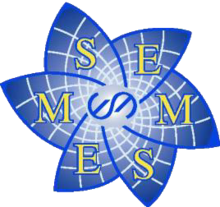Beautiful Symmetry
Adult colouring books with complicated mandalas and other fine patterns are currently popular. Long before this hype, the work or M.C. Escher and the Islamic patterns such as in the Alhambra in Spain, display explicit and complicated symmetric patterns that have attracted the interest and admiration of people of previous centuries whether they are mathematicians or not. Alex Berke is a computer scientist who is currently graduate student at the MIT Media Lab. He must have thought that the colouring hype of symmetric patterns could be easily applied to teach some elements and concepts of mathematical group theory. The result is this paper colouring book and, in parallel, an on-line version where you see all the rotations, reflections, and translations dynamically illustrated.
The book has no colours, and shows only patterns in black and white. So, the colouring experience is certainly the most blatant fun aspect of this book. However the colouring should not be inspired by personal artistic creativity. The book is challenging in the sense that the reader has to colour the graphics in such a way that certain restrictive conditions are satisfied. For example in a given black-and-white D4 pattern (4-fold rotational symmetry and 4 mirror symmetry axes) the colours should only leave 2-fold rotational symmetries, or looses all its mirror symmetries. Thus the reader is introduced to some mathematical aspects of symmetry to eventually learn the concepts of a cyclic group Cn (containing only n-fold rotations) or the dihedral group Dn (having the symmetry of a regular n-gon with n-fold rotations and n different symmetry axes). In a playful way the reader-colourist learns the concept of a (finite) group and its order. He/she realizes quickly that there must be something like a subgroup, and that the order of a subgroup must divide the order of the group, and that a cyclic group has just one generator, and similar elementary properties.
In a first part only rotations and cyclic groups are discussed. Then reflections are introduced, which, in combination with rotations, generates the dihedral groups of regular polygons. Next translations are added and things then become a little bit more challenging when these are combined with reflections and rotations to generate (infinite) frieze groups. Colouring the patterns becomes more difficult since one has to deal with horizontal and vertical mirror reflections, and glide reflections as well as rotations. The seven frieze groups are obtained, but to illustrate that the mathematics stay in the background, there is for example no formal theorem or proof that these seven friezes are the only ones possible. The reader is just asked to try and use a combination of the known transformations to find a pattern that is different from the seven friezes obtained, but of course none can be found.
While frieze groups are generated using translations in only one direction, wallpaper groups are based on translations in two directions. This gives many more possibilities, and yet there are only 17 different wallpaper groups. Berke goes through all 17, basically just showing the patterns and asking the reader to find the rotations, symmetry axes, and other transformations that are involved.
Berke has chosen for his book the orbifold notation of Conway to indicate the frieze and wallpaper patterns. This is not so easy to remember and interpret for a lay person. So, for reference, this is recalled in an appendix, just like one can find there also some very elementary mathematical definitions. Answers to the challenges are not given there but some can be found on-line at the website of the book, where one should look for solutions. If you go to the online version you can also find dynamically generated frieze and wallpaper patterns, and even more circular patterns that will interactively generate random mandala-like circular patterns using the building blocks used throughout the book. The idea is that these are downloaded and printed so that they can be coloured. The menu of the online version also has a link to fractals (Sierpiński triangle, Sierpiński arrowhead curve, Pythagoras tree), which are not discussed in this book. All this is based on software that is also available via github (it's an open source project).
The book is both fun and challenging. If you love colouring patterns, you will enjoy it, and you will learn some (elementary) concepts of group theory. The fact that you are challenged to colour in such a way that you meet the conditions that are the subject of the exercise, is the learning element. Little children who love to smudge their colour books filled with princesses, gnomes, and flowers, will have no message here. If you want to learn something about groups, you may have lost that childish kind of love for colouring, and then it may look like a lot of colouring to learn only a little. So it may be just right for the youngsters (or adults) who love to puzzle, and solve riddles and sudokus, and that usually form the bulk of the public at math fairs. But they will perhaps not actually be colouring every pattern throughout the book. I can imagine that they will only choose some that they will actually colour and do the colouring for the others only mentally. If you are teaching an introduction to groups it will be a wonderful tool to generate problems to test your students with, and there is a lot of inspiration to be found if you want to organize a hands-on session at a math meeting for youngsters or for a generally interested public. The mathematical interest of eager colourists can be raised and perhaps they will look up some books or websites to learn more on symmetry groups, and detect these patterns also in Islamic decorations or in the work of Escher.
